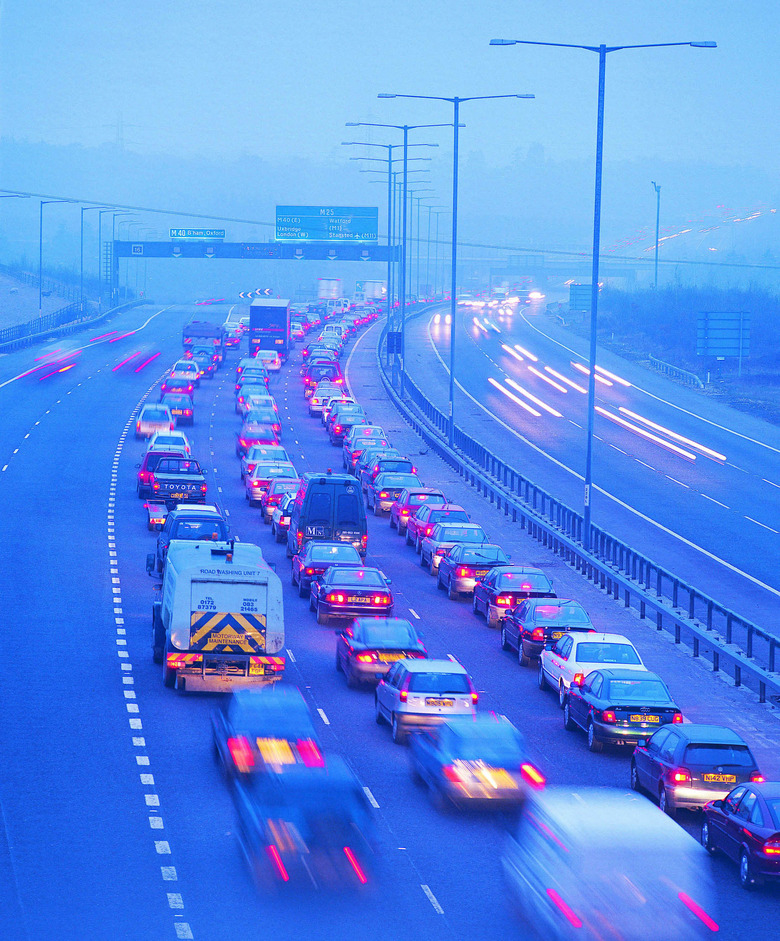The Causes, Effects & Solutions For Air Pollution
A Massachusetts Institute of Technology study found that air pollution was killing about 200,000 Americans annually as of 2005, primarily from transportation and power generation. Living in densely populated cities may also raise your likelihood of air pollution exposure from industrial and transportation emissions. Pollution particles can be microscopically miniature, small enough to breathe in and enter the human bloodstream. The effects of air pollution aren't restricted to humans and may be felt globally by all living things.
Pollution Sources
Pollution Sources
Almost 85 percent of US energy comes from non-renewable carbon-based fossil fuels including coal, natural gas and oil, which release pollutants such as benzene, sulfur monoxide and nitrogen dioxide. Photochemical reactions occur when oxides are exposed to sunlight in the atmosphere resulting in poisonous ozone close to the ground where humans live. Heavy metals like lead, cadmium, mercury and arsenic are often used in the manufacturing of consumer electronic goods and can enter the environment during production and when a consumer throws them away. Indoor air pollution like tobacco smoke, pet dander, molds and asbestos can also cause poor air quality. There are natural causes of air pollution, including volcanic ash eruptions and forest-fire smoke.
Global Impacts
Global Impacts
Each source of pollution, including outdoor fossil-fuel emissions, industrial and city waste, household chemicals, agricultural waste, insecticides and indoor pollution can be potentially harmful to humans and the environment. The average adult breathes nearly 3,000 gallons of air in per day. Air pollution has been linked to a wide range of human health problems, including low birth weight, asthma, bronchitis, high blood pressure and even premature death. Other environmental impacts of air pollution include acid rain, contaminated water and increased atmospheric greenhouse gases, such as carbon dioxide, that trap heat above the Earth and lead to a global-warming effect. Through global warming, it's possible to have more flooding events, severe weather and an increased risk of famine and plagues from the resulting climate changes.
Green Infrastructure
Green Infrastructure
Reducing air pollution emissions isn't easy because it requires a balance between demanding consumers and capital-seeking commercial businesses. Alternative energy sources that are renewable, such as wind-turbine farms, hydroelectric underwater propeller systems, solar panel rooftops and geothermal energy from inside the Earth offer great long-term infrastructure solutions to clean power generation. Mass transportation powered by bio-fuels like corn and fish oil could also significantly reduce pollution. Promising futuristic solutions to pollution include designing walkable cities where human interactions are favored over carbon-emitting cars.
Living Green
Living Green
Living green is a lifestyle requiring a combined individual and community effort to promote a healthy natural environment that can sustain future generations. By using Energy Star-efficient appliances, planting trees, buying local organic produce, creating community gardens and parks, reusing materials, participating in recycling programs and using green energy such as hydro, solar and wind power, pollution can be significantly reduced. Homeowners who install Energy Star-efficient appliances can save between 20 to 30 percent of the energy used by the typical home. Individual actions, such as properly insulating a home, walking or riding a bike, car pooling and turning off lights in rooms that aren't in use, will also reduce air pollution.
Cite This Article
MLA
Alonzo, Ben. "The Causes, Effects & Solutions For Air Pollution" sciencing.com, https://www.sciencing.com/causes-effects-solutions-air-pollution-11107/. 24 April 2017.
APA
Alonzo, Ben. (2017, April 24). The Causes, Effects & Solutions For Air Pollution. sciencing.com. Retrieved from https://www.sciencing.com/causes-effects-solutions-air-pollution-11107/
Chicago
Alonzo, Ben. The Causes, Effects & Solutions For Air Pollution last modified March 24, 2022. https://www.sciencing.com/causes-effects-solutions-air-pollution-11107/
